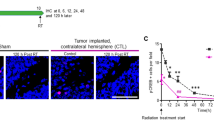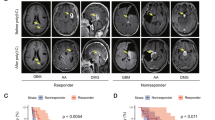Abstract
The immunosuppressive environment of malignant gliomas is likely to suppress the anti-tumor activity of infiltrating microglial cells and lymphocytes. Macrophages and microglial cells may be activated by oligonucleotides containing unmethylated CpG-motifs, although their value in cancer immunotherapy has remained controversial. Following injection of CpG-containing oligonucleotides (ODN) into normal rat brain, we observed a local inflammatory response with CD8+ T cell infiltration, upregulation of MHC 2, and ED1 expression proving the immunogenic capacity of the CpG-ODN used. This was not observed with a control ODN mutated in the immunostimulatory sequence (m-CpG). To study their effect in a syngeneic tumor model, we implanted rat 9L gliosarcoma cells into the striatum of Fisher 344 rats. After 3 days, immunostimulatory CpG-ODN, control m-CpG-ODN, or saline was injected stereotactically into the tumors (day 3 group). In another group of animals (day 0 group), CpG-ODN were mixed with 9L cells prior to implantation without further treatment on day 3. After 3 weeks, the animals were killed and the brains and spleens were removed. Rather unexpectedly, the tumors in several of the animals treated with CpG-ODN (both day 0 and day 3 group) were larger than in saline or m-CpG-ODN treated control animals. The tumor size in CpG-ODN-treated animals was more variable than in both control groups. This was associated with inflammatory responses and necrosis which was observed in most tumors following CpG treatment. This, however, did not prevent excessive growth of solid tumor masses in the CpG-treated animals similar to the control-treated animals. Dense infiltration with microglial cells resembling ramified microglia was observed within the solid tumor masses of control- and CpG-treated animals. In necrotic areas (phagocytic), activation of microglial cells was suggested by ED1 expression and a more macrophage-like morphology. Dense lymphocytic infiltrates consisting predominantly of CD8+ T cells and fewer NK cells were detected in all tumors including the control-treated animals. Expression of perforin serving as a marker for T cell or NK cell activation was detected only on isolated cells in all treatment groups. Tumors of all treatment groups revealed CD25 expression indicating T cells presumed to maintain peripheral tolerance to self-antigens. Cytotoxic T cell assays with in vitro restimulated lymphocytes (51chromium release assay) as well as interferon-gamma production by fresh splenocytes (Elispot assay) revealed specific responses to 9L cells but not another syngeneic cell line (MADB 106 adenocarcinoma). Surprisingly, the lysis rates with lymphocytes from CpG-ODN-treated animals were lower compared to control-treated animals. The tumor size of individual animals did not correlate with the response in both immune assays. Taken together, our data support the immunostimulatory capacity of CpG-ODN in normal brain. However, intratumoral application proved ineffective in a rat glioma model. CpG-ODN treatment may not yield beneficial effects in glioma patients.





Similar content being viewed by others
References
Auf G, Carpentier AF, Chen L, Le Clanche C, Delattre JY (2001) Implication of macrophages in tumor rejection induced by CpG-oligodeoxynucleotides without antigen. Clin Cancer Res 7:3540–3543
Badie B, Bartley B, Schartner J (2002) Differential expression of MHC class II and B7 costimulatory molecules by microglia in rodent gliomas. J Neuroimmunol 133:39–45
Badie B, Schartner J, Prabakaran S, Paul J, Vorpahl J (2001) Expression of Fas ligand by microglia: possible role in glioma immune evasion. J Neuroimmunol 120:19–24
Barclay AN (1981) The localization of populations of lymphocytes defined by monoclonal antibodies in rat lymphoid tissues. Immunology 42:593–600
Buhtoiarov IN, Sondel PM, Eickhoff JC, Rakhmilevich AL (2007) Macrophages are essential for antitumour effects against weakly immunogenic murine tumours induced by class B CpG-oligodeoxynucleotides. Immunology 120:412–423
Carpentier A, Laigle-Donadey F, Zohar S, Capelle L, Behin A, Tibi A, Martin-Duverneuil N, Sanson M, Lacomblez L, Taillibert S, Puybasset L, Van Effenterre R, Delattre JY, Carpentier AF (2006) Phase 1 trial of a CpG oligodeoxynucleotide for patients with recurrent glioblastoma. Neuro Oncol 8:60–66
Carpentier AF, Meng Y (2006) Recent advances in immunotherapy for human glioma. Curr Opin Oncol 18:631–636
Carpentier AF, Xie J, Mokhtari K, Delattre JY (2000) Successful treatment of intracranial gliomas in rat by oligodeoxynucleotides containing CpG motifs. Clin Cancer Res 6:2469–2473
Damoiseaux JG, Dopp EA, Calame W, Chao D, MacPherson GG, Dijkstra CD (1994) Rat macrophage lysosomal membrane antigen recognized by monoclonal antibody ED1. Immunology 83:140–147
Ehtesham M, Black KL, Yu JS (2004) Recent progress in immunotherapy for malignant glioma: treatment strategies and results from clinical trials. Cancer Control 11:192–207
El Andaloussi A, Han Y, Lesniak MS (2006) Prolongation of survival following depletion of CD4+CD25+ regulatory T cells in mice with experimental brain tumors. J Neurosurg 105:430–437
El Andaloussi A, Sonabend AM, Han Y, Lesniak MS (2006) Stimulation of TLR9 with CpG ODN enhances apoptosis of glioma and prolongs the survival of mice with experimental brain tumors. Glia 54:526–535
Fecci PE, Mitchell DA, Whitesides JF, Xie W, Friedman AH, Archer GE, Herndon JE 2nd, Bigner DD, Dranoff G, Sampson JH (2006) Increased regulatory T-cell fraction amidst a diminished CD4 compartment explains cellular immune defects in patients with malignant glioma. Cancer Res 66:3294–3302
Fecci PE, Sweeney AE, Grossi PM, Nair SK, Learn CA, Mitchell DA, Cui X, Cummings TJ, Bigner DD, Gilboa E, Sampson JH (2006) Systemic anti-CD25 monoclonal antibody administration safely enhances immunity in murine glioma without eliminating regulatory T cells. Clin Cancer Res 12:4294–4305
Ginzkey C, Eicker SO, Krause J, Brecht S, Hugo HH, Marget M, Mehdorn HM, Steinmann J, Hamel W (2009) DNA vaccination against rat gliomas expressing the E. coli lacZ gene as a model antigen (submitted)
Graeber MB, Scheithauer BW, Kreutzberg GW (2002) Microglia in brain tumors. Glia 40:252–259
Grauer OM, Molling JW, Bennink E, Toonen LW, Sutmuller RP, Nierkens S, Adema GJ (2008) TLR ligands in the local treatment of established intracerebral murine gliomas. J Immunol 181:6720–6729
Hartmann G, Weeratna RD, Ballas ZK, Payette P, Blackwell S, Suparto I, Rasmussen WL, Waldschmidt M, Sajuthi D, Purcell RH, Davis HL, Krieg AM (2000) Delineation of a CpG phosphorothioate oligodeoxynucleotide for activating primate immune responses in vitro and in vivo. J Immunol 164:1617–1624
Heiser A, Coleman D, Dannull J, Yancey D, Maurice MA, Lallas CD, Dahm P, Niedzwiecki D, Gilboa E, Vieweg J (2002) Autologous dendritic cells transfected with prostate-specific antigen RNA stimulate CTL responses against metastatic prostate tumors. J Clin Invest 109:409–417
Ilvesaro JM, Merrell MA, Swain TM, Davidson J, Zayzafoon M, Harris KW, Selander KS (2007) Toll like receptor-9 agonists stimulate prostate cancer invasion in vitro. Prostate 67:774–781
Jander S, Schroeter M, D’Urso D, Gillen C, Witte OW, Stoll G (1998) Focal ischaemia of the rat brain elicits an unusual inflammatory response: early appearance of CD8+ macrophages/microglia. Eur J Neurosci 10:680–688
Jurk M, Vollmer J (2007) Therapeutic applications of synthetic CpG oligodeoxynucleotides as TLR9 agonists for immune modulation. BioDrugs 21:387–401
Krieg AM (2007) Development of TLR9 agonists for cancer therapy. J Clin Invest 117:1184–1194
Meng Y, Carpentier AF, Chen L, Boisserie G, Simon JM, Mazeron JJ, Delattre JY (2005) Successful combination of local CpG-ODN and radiotherapy in malignant glioma. Int J Cancer 116:992–997
Merrell MA, Ilvesaro JM, Lehtonen N, Sorsa T, Gehrs B, Rosenthal E, Chen D, Shackley B, Harris KW, Selander KS (2006) Toll-like receptor 9 agonists promote cellular invasion by increasing matrix metalloproteinase activity. Mol Cancer Res 4:437–447
Perry VH, Gordon S (1987) Modulation of CD4 antigen on macrophages and microglia in rat brain. J Exp Med 166:1138–1143
Roman M, Martin-Orozco E, Goodman JS, Nguyen MD, Sato Y, Ronaghy A, Kornbluth RS, Richman DD, Carson DA, Raz E (1997) Immunostimulatory DNA sequences function as T helper-1-promoting adjuvants. Nat Med 3:849–854
Schabowsky RH, Madireddi S, Sharma R, Yolcu ES, Shirwan H (2007) Targeting CD4+CD25+FoxP3+ regulatory T-cells for the augmentation of cancer immunotherapy. Curr Opin Investig Drugs 8:1002–1008
Schartner JM, Hagar AR, Van Handel M, Zhang L, Nadkarni N, Badie B (2005) Impaired capacity for upregulation of MHC class II in tumor-associated microglia. Glia 51:279–285
Schluesener HJ, Seid K, Deininger M, Schwab J (2001) Transient in vivo activation of rat brain macrophages/microglial cells and astrocytes by immunostimulatory multiple CpG oligonucleotides. J Neuroimmunol 113:89–94
Steinmann J, Kaden J, May G, Schroder K, Herwartz C, Muller-Ruchholtz W (1994) Failure of in vitro T-cell assays to predict clinical outcome after human kidney transplantation. J Clin Lab Anal 8:157–162
Watters JJ, Schartner JM, Badie B (2005) Microglia function in brain tumors. J Neurosci Res 81:447–455
Zeis M, Siegel S, Wagner A, Schmitz M, Marget M, Kuhl-Burmeister R, Adamzik I, Kabelitz D, Dreger P, Schmitz N, Heiser A (2003) Generation of cytotoxic responses in mice and human individuals against hematological malignancies using survivin-RNA-transfected dendritic cells. J Immunol 170:5391–5397
Acknowledgments
We are indebted to Dr. Axel Heiser for his support in performing the Elispot assays. We thank Dr. T. von Hörsten (Medizinische Hochschule Hannover, Germany) for supplying us with the MADB 106 adenocarcinoma cell line. The Iba1 antibody was a kind gift from Dr. Y. Imai (Department of Neurochemistry, National Institute of Neuroscience, Tokyo). The technical support by Mrs. Bärbel Hufnagel is appreciated. This work has been supported by the ‘Interdisziplinäres Zentrum für Krebsforschung der Christian-Albrechts Universität zu Kiel’ and by the ‘Hensel Stiftung’.
Author information
Authors and Affiliations
Corresponding author
Rights and permissions
About this article
Cite this article
Ginzkey, C., Eicker , S.O., Marget, M. et al. Increase in tumor size following intratumoral injection of immunostimulatory CpG-containing oligonucleotides in a rat glioma model. Cancer Immunol Immunother 59, 541–551 (2010). https://doi.org/10.1007/s00262-009-0771-y
Received:
Accepted:
Published:
Issue Date:
DOI: https://doi.org/10.1007/s00262-009-0771-y




